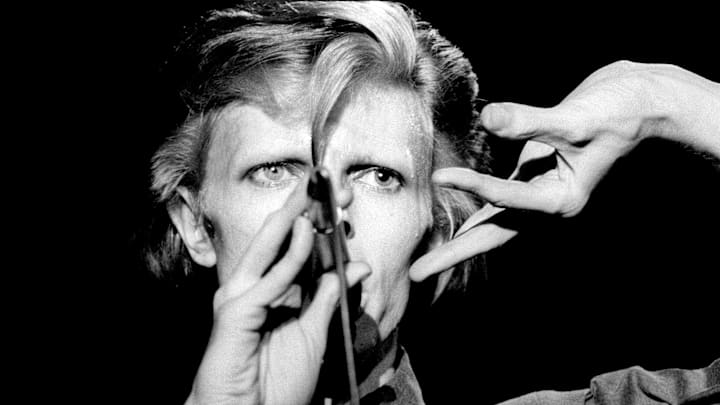David Bowie's Space Oddity" was a transformative album, but Diamond Dogs, released in the summer of 1974, marked another significant transition in his illustrious career. Originally planned as an ambitious adaptation of George Orwell’s dystopian novel, 1984, the album reflects Bowie's unique vision and musical prowess.
By 1974, Bowie had already ridden and shaped the pop culture wave, impacting the industry much like Elvis Presley, the Beatles, or the Rolling Stones. However, as the glam-rock era was nearing its end, Bowie was on the cusp of transforming his musical style once again.
Despite getting mixed reviews initially, the album achieved commercial success, reaching No. 1 in the UK and No. 5 in the US. Although it didn't match the astronomical success of Ed Sheeran's hideously, intentionally generic "Shape of You," chart success doesn't always correlate with artistic quality. NME's early review described it as "a rather grandiose mood piece… It’s okay, you know, but is it really necessary?" However, NME later revised its opinion, ranking "Diamond Dogs" at No. 447 in its 2013 list of "The 500 Greatest Albums of All Time" (also, technically, is any album truly necessary?).
Bowie himself acknowledged the album's challenges. In a 1974 interview with Robert Hilburn, he stated, "It was not a concept album. It was a collection of things. And I didn’t have a band. So that’s where the tension came in. I couldn’t believe I had finished it when I did. I had done so much of it myself. I never want to be in that position again."
David Bowie and the classic songs of Diamond Dogs
Despite the album's perceived limitations, Diamond Dogs remains a testament to Bowie's genius, with "Rebel Rebel" standing alongside other classics like "Young Americans" and "Fame." It showcases his skills as a songwriter, singer, guitarist, saxophonist, keyboard player, producer, and media innovator.
Primarily recorded in London at Olympic Studios and in Hilversum, Netherlands, between December 1973 and February 1974, Bowie faced the challenge of filling the void left by guitarist Mick Ronson, whom he had disbanded from the Spiders From Mars. Angie Bowie, his wife at the time, said, "David was furious" after the Spiders demanded a pay raise and had threatened to leave on the next plane if they didn't get it. Bowie considered it "disloyalty." Displaying ambition and bravado, Bowie took on many of the guitar duties himself.
Bowie became more DIY
Reflecting in 1997, he said, "That couple of months I spent putting [Diamond Dogs] together before I went into the studio was probably the only time in my life where I really buckled down to learn the stuff I needed to have on the album."
Bowie also parted ways with long-time producer Ken Scott and initially planned to play every instrument on the album. Eventually, he enlisted session bass player Herbie Flowers and drummer Tony Newman, who had also played on Donovan's Barabajagal (1968) and Jeff Beck's Beck-Ola (1969). Pianist Mike Garson and drummer Aynsley Dunbar, who had contributed to Bowie's previous album Pin Ups, also played on the album.
1984 The Musical?
In the lead-up to Diamond Dogs, Bowie had grand plans for a "full-scale rock musical" retelling the story of Ziggy Stardust and a TV musical production of George Orwell’s Nineteen Eighty-Four. However, he couldn't secure the theatrical rights to Orwell's novel. Instead, he reimagined the concept into Diamond Dogs, set in the dystopian Hunger City.
The album opens with "Future Legend," a synth-heavy track introducing a post-apocalyptic landscape. This transitions into the title track, which carries noticeable influences from Mick Jagger and Keith Richards. Interestingly, The Rolling Stones were recording their album It’s Only Rock’n’Roll at Olympic Studios simultaneously with Bowie, leading to some cross-pollination of ideas and social interactions.
More about the music

"Rebel Rebel," recorded on December 27, 1973, stands out as a flagship track. Released as a single in February 1974, it reached No. 5 in the UK. The song features an iconic riff and lyrics that remain relevant today: "You've got your mother in a whirl, 'cos she's not sure if you're a boy or a girl."
Diamond Dogs includes a three-piece song suite: "Sweet Thing/Candidate/Sweet Thing (Reprise)," originally intended for the Nineteen Eighty-Four stage production. This suite exemplifies Bowie’s innovative arrangements and his use of the 'cut-up' technique, inspired by writer William S. Burroughs.
Side 2 of the album, influenced by Orwell’s novel, includes tracks like "We Are The Dead," "Rock 'N' Roll With Me," and "Big Brother," hinting at the musical shift Bowie would make with his next album, Young Americans. The track "1984" reflects Bowie's fascination with soul music, inspired by Isaac Hayes’s Shaft soundtrack and Barry White's sound.
The strange cover
The album's cover art, by Belgian artist Guy Peellaert, features Bowie morphing into a dog, a concept inspired by a conversation with Mick Jagger. The elaborate and ambitious tour for the album set new standards for theatrical rock performances, though it faced technical challenges and eventually evolved into the Soul Tour to promote Young Americans.
Diamond Dogs remains an iconic part of Bowie's discography, representing a pivotal moment of change and creativity in his career.
